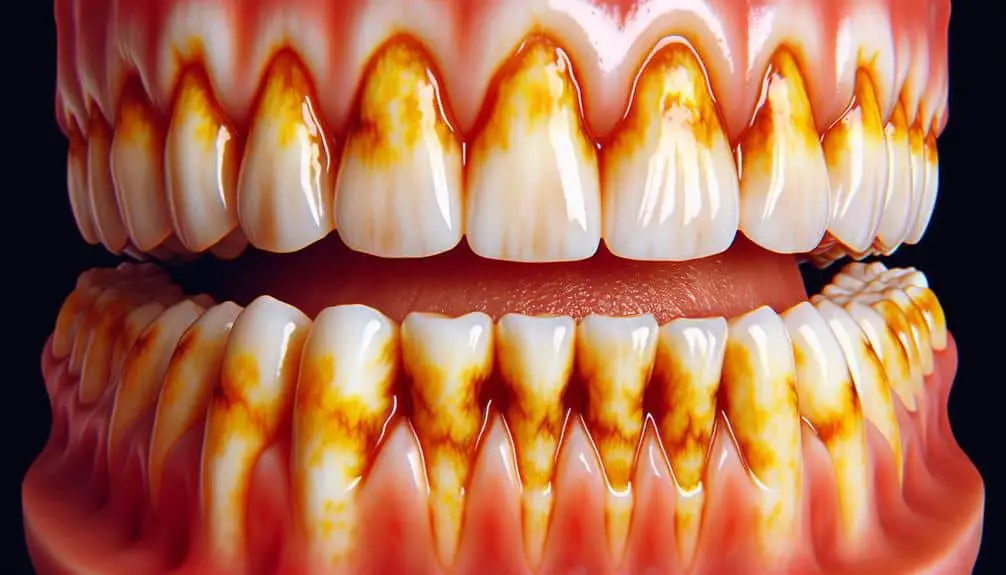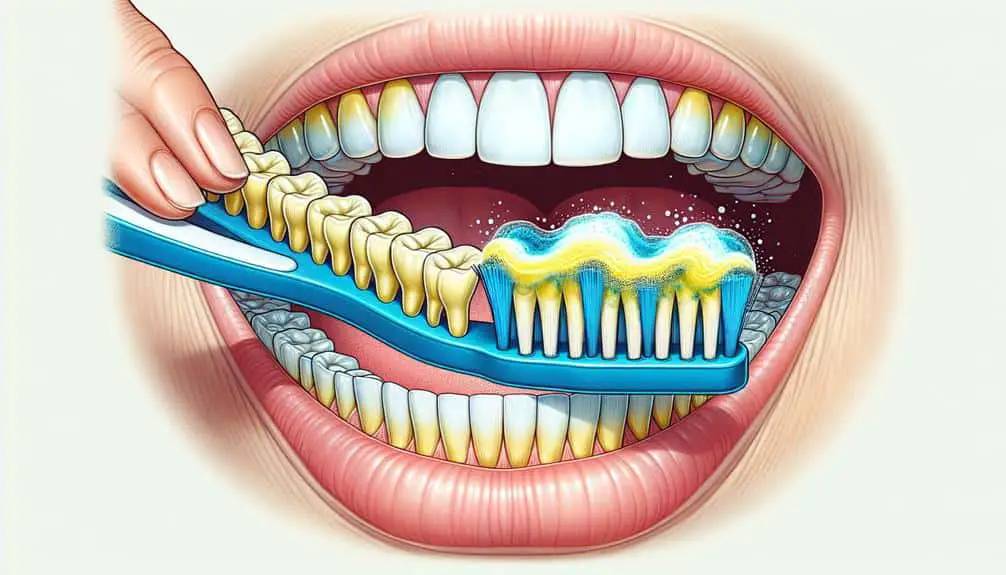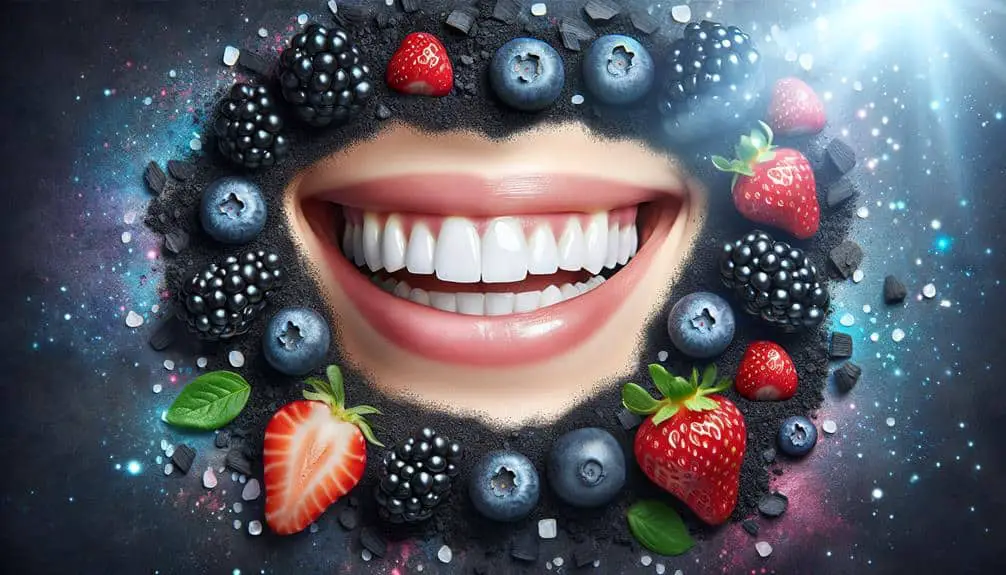Whitening fluoride-stained teeth is tough due to intrinsic stains within enamel caused by excess fluoride during tooth development. These stains disrupt enamel formation, making evaluation challenging. Higher fluoride levels intensify staining, weakening enamel. Successful whitening requires evaluating fluoride accumulation and enamel damage. Professional treatments like bleaching and microabrasion can help, along with home remedies like baking soda and hydrogen peroxide. Prevent fluorosis and staining by monitoring fluoride consumption and maintaining oral hygiene. Understanding these factors is key to achieving a brighter smile.
Key Points
- Intrinsic nature of stains in enamel resists typical whitening methods.
- Excessive fluoride weakens enamel, making it more vulnerable to staining.
- Severity of fluorosis determines difficulty in achieving whiter teeth.
- Fluoride-stained enamel damage hinders traditional whitening effectiveness.
- Successful whitening requires assessment of enamel damage and tailored approaches.
Understanding Fluorosis and Tooth Discoloration
Understanding the causes of fluorosis and tooth discoloration can provide valuable insights into how to effectively whiten fluoride-stained teeth. Fluorosis occurs when developing teeth are exposed to excessive fluoride, leading to a range of effects such as white streaks, brown spots, or surface pitting. The primary cause of fluorosis is the ingestion of too much fluoride during the tooth-forming years, typically under the age of 8. This excess fluoride disrupts enamel formation, resulting in the significant discolorations associated with fluorosis.
The effects of fluorosis on tooth color can vary depending on the severity of the condition. Mild fluorosis may manifest as faint white streaks, while moderate to severe cases can present as brown stains or even visible pits on the tooth surface. These discolorations are challenging to remove through regular brushing or over-the-counter whitening products due to the intrinsic nature of the stains within the enamel. Understanding these causes and effects is essential for developing effective strategies to whiten fluoride-stained teeth.
Factors Impacting Fluoride-Stained Tooth Whiteness
To enhance the whiteness of fluoride-stained teeth, it's important to take into account various factors that impact the effectiveness of whitening treatments. Fluoride levels in the enamel play a vital role in the discoloration of teeth, with higher levels often leading to more severe staining. When examining whitening options, understanding the extent of fluoride accumulation in the teeth is essential for successful treatment outcomes.
Enamel damage is another significant factor to take into consideration when addressing fluoride-stained tooth whiteness. The presence of fluoride can weaken the enamel, making it more porous and susceptible to staining. Before undergoing any whitening procedures, it's essential to assess the extent of enamel damage caused by fluoride exposure. This evaluation will help determine the most suitable whitening approach while minimizing the risk of further harming the enamel.
Professional Dental Treatments for Fluoride Stains
Professional dental treatments offer effective solutions for addressing fluoride stains on teeth, providing specialized care to enhance the whiteness and overall appearance of your smile. When dealing with fluoride-stained teeth, dentists may recommend the following treatments:
- Dental Bleaching: This procedure involves applying a bleaching agent to the teeth, which helps break down and lighten the stains, restoring a brighter smile.
- Enamel Microabrasion: Through this technique, a dentist removes a thin layer of enamel that contains the fluoride stains, revealing the whiter enamel underneath.
- Professional Cleaning: Dentists may perform a deep cleaning to remove surface stains and plaque buildup, improving the overall appearance of the teeth.
- Bonding: In cases where stains are severe, bonding can be used to cover the stained areas with a tooth-colored resin, giving a uniform appearance to the teeth.
- Veneers: For more persistent stains, veneers can be placed on the front surface of the teeth, providing a long-lasting solution for achieving a bright, white smile.
Home Remedies for Whitening Fluoride-Stained Teeth
For individuals seeking alternative approaches to brighten fluoride-stained teeth at home, incorporating simple yet effective remedies can help improve the overall appearance of your smile. Natural remedies and DIY solutions can be gentle yet beneficial options for addressing fluoride stains on teeth. One common method is using baking soda as a mild abrasive to help scrub away surface stains. Creating a paste with baking soda and water, then gently brushing your teeth with it, can gradually reduce the appearance of fluoride staining.
Another popular home remedy involves using hydrogen peroxide as a natural whitening agent. Mixing hydrogen peroxide with water to dilute its concentration and using it as a mouthwash can help lighten fluoride stains over time. However, it's important to use this solution in moderation to prevent any potential damage to your teeth and gums.
Additionally, consuming crunchy fruits and vegetables like apples and carrots can act as natural teeth cleaners, helping to scrub away surface stains. These simple DIY approaches can complement your oral hygiene routine and contribute to a brighter smile.
Prevention Tips to Avoid Fluorosis and Staining
Implementing proper dental hygiene practices and monitoring fluoride intake are key strategies in preventing fluorosis and staining on teeth. To safeguard your dental health and avoid fluoride-related discoloration, consider the following tips:
- Dietary habits: Be mindful of your fluoride consumption from sources like water, beverages, and foods. Opt for low-fluoride alternatives when possible.
- Oral hygiene practices: Brush your teeth at least twice a day with fluoride toothpaste and floss regularly to remove plaque and prevent staining.
- Fluoride intake monitoring: Keep track of your fluoride intake from all sources, including dental products and supplements, to stay within safe limits.
- Regular dental check-ups: Visit your dentist for routine check-ups and professional cleanings to detect early signs of fluorosis and receive appropriate guidance.
- Consultation with a professional: If you have concerns about fluoride exposure or staining, consult with a dental professional for personalized advice and preventive measures.
Frequently Asked Questions
Can Fluoride-Stained Teeth Be Completely Whitened to Match the Rest of the Teeth?
Whitening options for fluoride-stained teeth can enhance their appearance but may have limitations in achieving a perfect match with the rest of your teeth. Address tooth sensitivity during treatment to guarantee a comfortable experience.
Are There Any Long-Term Effects of Having Fluoride-Stained Teeth?
Long-term effects of fluoride-stained teeth could lead to potential complications like self-consciousness due to cosmetic concerns. Consistent dental care and professional guidance can help manage these effects, ensuring your oral health and confidence remain exceptional.
Can Children With Fluorosis Benefit From Professional Whitening Treatments?
For children with fluorosis, professional whitening options can help address staining. Professional treatments tailored for fluorosis can improve the appearance of teeth. Consult a dentist to explore safe and effective ways to whiten teeth affected by fluorosis.
How Do Fluoride-Stained Teeth Affect the Overall Health of the Teeth and Gums?
Fluoride-stained teeth can impact dental health by weakening enamel and increasing susceptibility to decay. Preventive measures like regular dental check-ups and proper oral hygiene are essential to mitigate dental health risks associated with fluoride staining.
Are There Any Alternative Treatments for Fluoride-Stained Teeth Besides Whitening?
To address fluoride-stained teeth without whitening, consider natural remedies or cosmetic dentistry options like veneers. Preventive measures include regular dental visits and dietary changes to minimize further staining. Discuss these alternatives with your dentist for personalized recommendations.



